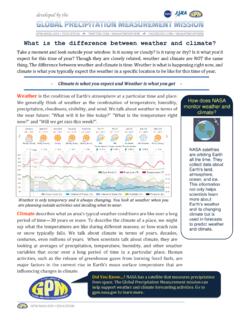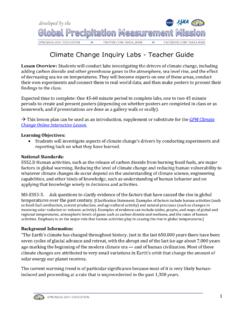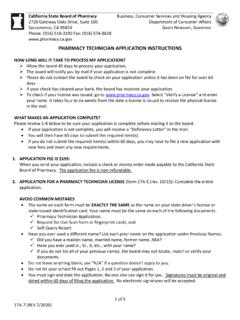Transcription of Geographical Influences on Climate - Teacher Guide - NASA
1 Geographical Influences on Climate Teacher Guide Lesson Overview: Students will compare the climatograms for different locations around the United States to observe patterns in temperature and precipitation. They will describe Geographical features near those locations, and compare graphs to find patterns in the effect of mountains, oceans, elevation, latitude, etc. on temperature and precipitation. Then, students will research temperature and precipitation patterns at various locations around the world using the MY NASA data Live Access Server and other sources, and use the information to create their own climatogram. Expected time to complete lesson: One 45 minute period to compare given climatograms, one to two 45 minute periods to research another location and create their own climatogram.
2 To lessen the time needed, you can provide students data rather than having them find it themselves (to focus on graphing and analysis), or give them the template to create a climatogram (to focus on the analysis and description), or give them the assignment for homework. See GPM Geographical Influences on Climate Climatogram Template and data for these options. Learning Objectives: - Students will brainstorm geographic features, consider how they might affect temperature and precipitation, and discuss the difference between weather and Climate . - Students will examine data about a location and calculate averages to compare with other locations to determine the effect of geographic features on temperature and precipitation. - Students will research the Climate patterns of a location and create a climatogram and description of what factors affect the Climate at that location.
3 National Standards: : Weather and Climate are influenced by interactions involving sunlight, the ocean, the atmosphere, ice, landforms, and living things. These interactions vary with latitude, altitude, and local and regional geography, all of which can affect oceanic and atmospheric flow patterns. MS-ESS2-6: Develop and use a model to describe how unequal heating and rotation of the Earth cause patterns of atmospheric and oceanic circulation that determine regional climates. [Clarification Statement: Emphasis is on how patterns vary by latitude, altitude, and geographic land distribution. Emphasis of atmospheric circulation is on the sunlight-driven latitudinal banding, the Coriolis effect, and resulting prevailing winds; emphasis of ocean circulation is on the transfer of heat by the global ocean convection cycle, which is constrained by the Coriolis effect and the outlines of continents.]
4 Examples of models can be diagrams, maps and globes, or digital representations.] [Assessment Boundary: Assessment does not include the dynamics of the Coriolis effect. From the Next Generation Science Standards, available at Background Information: Many factors affect the Climate of a location. The first important distinction to understand is the difference between weather and Climate weather is the short-term conditions of the atmosphere, such as temperature, precipitation, humidity, etc. Climate is the longer-term patterns in an area. For more information about the differences and how and why NASA studies Climate , visit 1. Latitude is a primary factor that has an influence on Climate , due to the relationship between the arth's tilt and the changing angle of incoming solar radiation at different times of the year.
5 This lesson does not primarily discuss latitudinal differences . For a lesson that does, see Some of the secondary factors that affect Climate are nearness to large bodies of water, elevation, the rain shadow effect of mountains, global wind and ocean current patterns, cloud cover, and surface albedo. This lesson primarily addresses the first three. In general, we expect cities near water to have a more moderate temperature (a smaller range between day and night and between seasons) and more precipitation, although this is affected by whether the location is on the windward or leeward side of the water based on prevailing wind patterns. Average temperature decreases with elevation, and precipitation is strongly affected by the nearness of mountains. The windward side of a mountain range will have higher precipitation, and the leeward side will often be in a rain shadow, with drastically decreased precipitation.
6 For more information, visit these links: Climate -13368032. Materials: - Printouts of climatograms (preferably in color, may be laminated to use repeatedly). - Access to computers for Climate research, or printouts of data for Teacher -chosen locations Engage: Using the GPM Geographical Influences on Climate - Presentation, discuss geographic features and how they might influence temperature and precipitation in a location (slide 3 & 4). Depending on the level of your students, you may need to discuss what a geographic feature actually is (especially if you have many English Language Learners). Students may be tempted to say that man-made features count roads, buildings, bridges, etc. You may wish to steer them toward natural features such as lakes, mountains, oceans, and so on, although the urban heat island effect could be discussed if you wish.
7 (For more information on heat islands: ) The clip-art pictures (a lake, river valley/hills, mountains and the ocean/beach) will appear after the text, so you can use them as hints if your students are having trouble coming up with ideas, or as vocabulary development for English Language Learners. The chart to record geographic features and their possible effect on Climate (slide 4), is intended to be completed on a smart board of some sort it could also be filled out on a white board or chart paper. As an additional engage activity, or as a more guided substitute for the brainstorming on slide 3, show them the image of an ash and steam plume from the Soufriere Hills volcano in Montserrat (slide 5). Students should notice that A appears to be somewhat elevated, while C is at sea level and right near the water.
8 B is clearly being affected by the ash plume from the volcano, which may lead into a discussion of short-term versus long-term factors. (A will always be at a higher elevation, and C will always be near water, but B will not always have an ash plume over it.) A. fuller discussion of weather versus Climate will occur later. 2. One of the key concepts to understand our Earth system is the difference between weather and Climate . Use the Venn diagram (slide 6) to compare and contrast the two. Ideally this should be done by filling out the diagram on a Smart Board. The primary difference here is the time scale - weather is looking at the short term; whether it will rain and what the temperature will be like for the next few days. Climate is looking at the long term; data averaged over a longer period of time.
9 It can actually be easier to make models that predict Climate over the long term, even though meteorologists can't always tell us accurately if it will rain tomorrow. Both weather and Climate measure temperature, precipitation, humidity, wind speed and direction, etc., but over a different time frame. Explore: Introduce the idea of a climatogram (a double graph that shows both temperature and precipitation averages for a location) with the sample for Washington, (slide 7). If you wish to make a climatogram for your own location instead, see the detailed directions at the end of this Teacher Guide . Here is a good opportunity to check for what students remember about graphs. Things to point out: - title - two axes, with different scales - units on the axes - the key (precipitation and temperature are Climate averages, measured over a long period).
10 - combination of bar graph for precipitation (total average rainfall per month, so discrete quantities) and line graph for temperature (continuous data ). To prepare students to look at the maps that include prevailing winds, show them the definition and diagrams relating to the term (slide 8), and then a sample map, also of Washington, (slide 9). These maps are similar to what students will see shortly in the exploration activity (see the document GPM Geographical Influences on Climate Cities Climatograms). The shaded relief shows mountains in brown you might point out the major ranges that are labeled. Large bodies of water (oceans, bays and large lakes) show in light blue rivers and streams are not generally included. The arrows show prevailing wind patterns.








